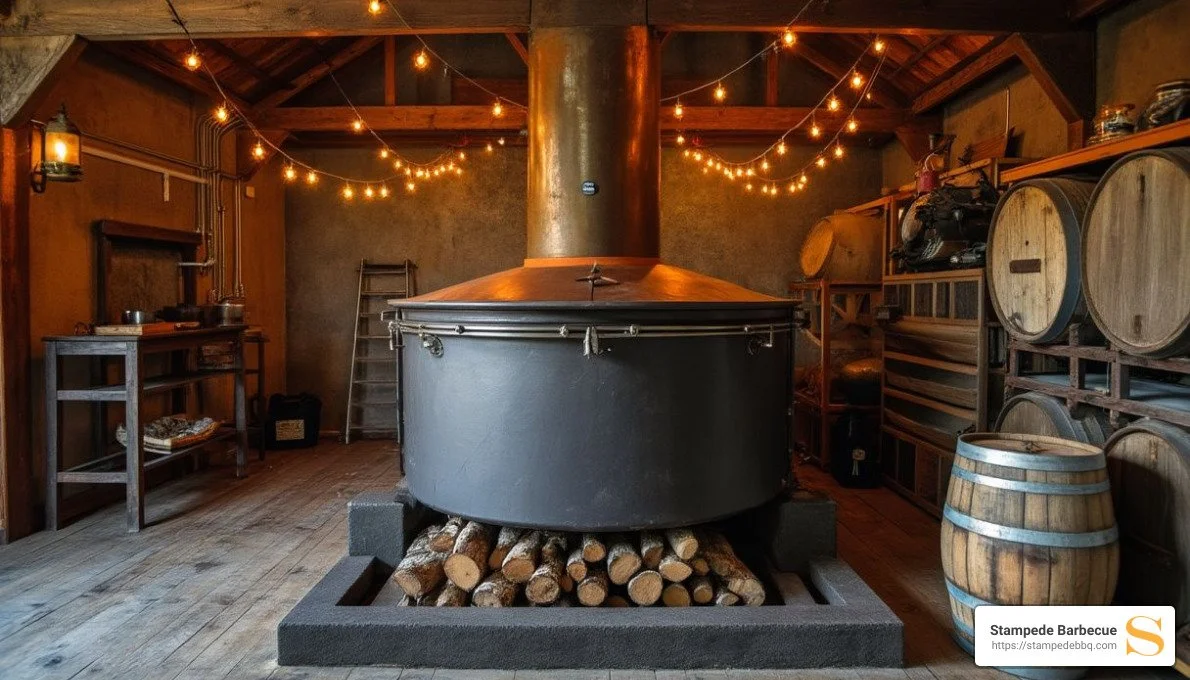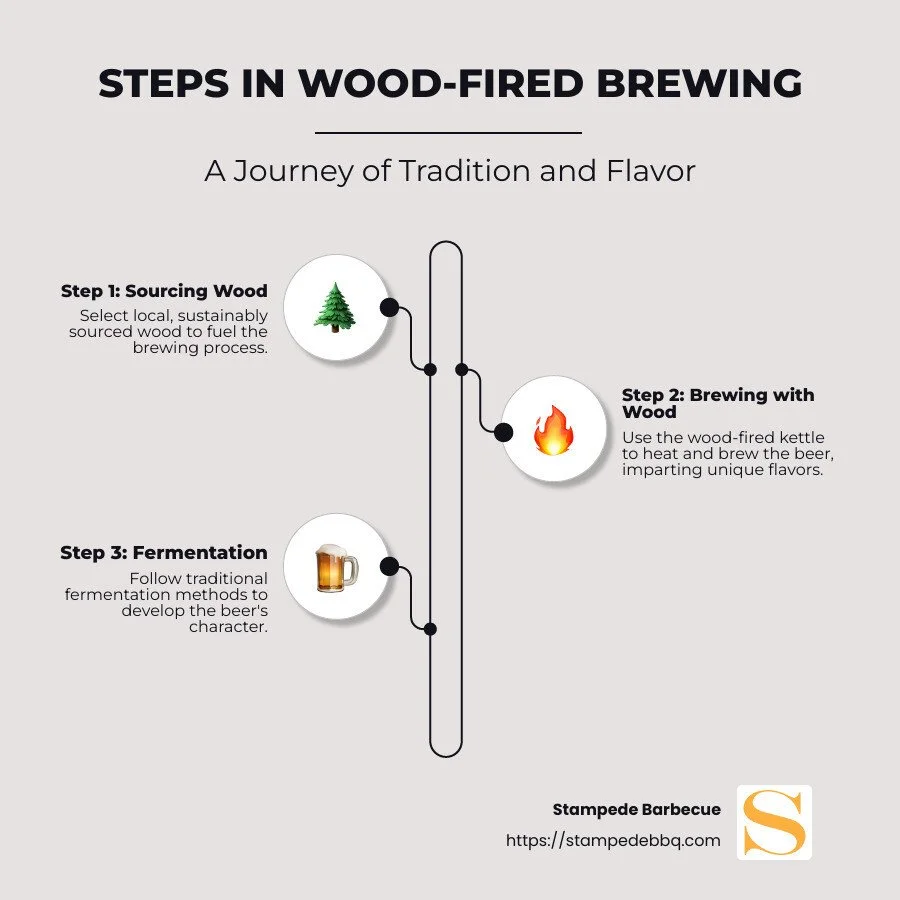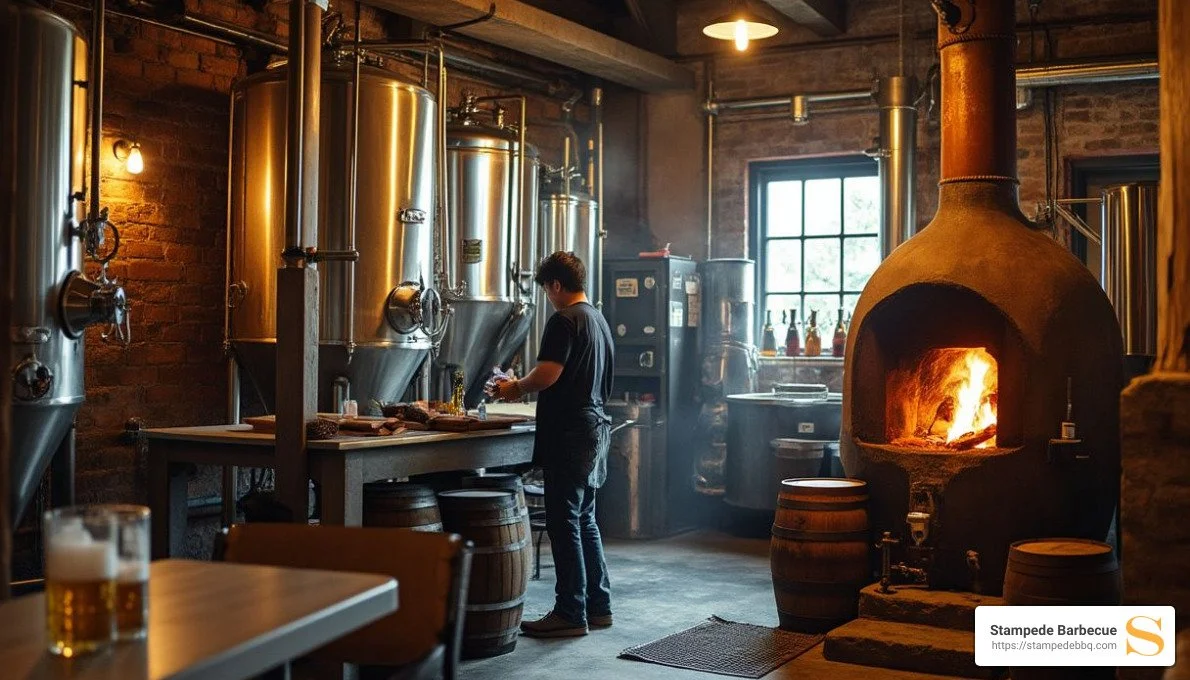From Flames to Foam: Discovering Wood-Fired Brewing
Wood-fired brewery is a term that evokes images of tradition and authenticity in the brewing world. These breweries use firewood to fuel their kettles, echoing ancient brewing methods that predate modern technologies. If you're curious about what makes a wood-fired brewery stand out, here are a few key points:
Traditional Methods: Brewing with wood-fired heat offers a connection to the past, maintaining practices that have been part of beer-making for centuries.
Unique Flavors: The use of wood can impart distinctive flavors to the beer, setting it apart from those produced using conventional energy sources.
Sustainability: Sourcing wood locally, often from reclaimed or naturally fallen trees, aligns many wood-fired breweries with sustainable and environmentally-friendly practices.
We'll dive into the fascinating world of wood-fired brewing, uncovering the art and tradition behind these remarkable breweries.
I'm Ryan Detwiler, co-founder of Stampede Barbecue. With over a decade in the barbecue and craft beer industry, I've seen the unique charm of a wood-fired brewery. Join me as we explore how these traditional brewing methods continue to inspire brewers and beer lovers alike.
The Art of Wood-Fired Brewing
Wood-fired brewing is not just a method; it's an art form that connects us to the roots of brewing traditions. At its core, a wood-fired brew system relies on the natural heat from burning wood to boil the wort, a crucial step in beer production.
Traditional Brewing
In the past, all brewing was wood-fired. This method has been preserved by a few dedicated brewers who appreciate the craft's historical significance. Brewing with wood involves more than just firing up a kettle. It requires understanding the nuances of heat control, which can greatly affect the brewing process. Unlike flipping a switch on an electric kettle, managing a wood fire demands constant attention, making it a true craftsmanship.
Handcrafted Beer
The beers produced in a wood-fired brewery are often described as handcrafted. This is because the brewer's hand is evident in every step of the process, from selecting the wood to managing the boil. This hands-on approach can lead to unique flavor profiles, as the type of wood and the way it's burned can impart subtle flavors to the beer.
At Stampede Barbecue, we embrace this artisanal approach. Our beers are crafted without the use of electricity or gas, staying true to the traditional methods. This dedication to tradition ensures that each brew is not just a drink, but a taste of history.
The Charm of the Past
The charm of wood-fired brewing lies in its authenticity. It's a method that honors the past while still producing exceptional beer. This connection to history is part of what makes wood-fired breweries so special. They offer a glimpse into how beer was made before the industrialization of the brewing process.
When convenience often trumps tradition, wood-fired breweries stand out. They remind us of the beauty of simplicity and the joy of creating something with our own hands.
As we dig deeper into wood-fired brewing, we'll explore the benefits these methods bring, from environmental sustainability to the unique flavors that can only be achieved through this time-honored approach.
Benefits of Wood-Fired Brewing
Unique Flavors
One of the most captivating aspects of wood-fired brewing is the unique flavors it imparts to the beer. When you brew with wood, the type of wood used can subtly influence the taste of the final product. For instance, different woods like oak or cherry can add distinct notes to the beer, enhancing its complexity. This adds a layer of depth that is often absent in beers brewed using conventional methods.
The artisanal approach of managing a wood fire allows for these flavors to develop naturally. Brewers who have mastered this technique create beers that tell a story with each sip. This hands-on method results in a beverage that is not only delicious but also a testament to the brewer's skill and dedication.
Sustainable Practices
Sustainability is another significant benefit of wood-fired brewing. By using wood, especially second-hand or sustainably sourced wood, breweries can reduce their carbon footprint. For example, sourcing wood from local businesses is more environmentally friendly than cutting down new trees.
This practice not only reduces waste but also supports local businesses, creating a more sustainable brewing cycle. In some regions, breweries even use wood-chip-fired heating systems, showcasing how local sourcing can be integrated into the brewing process to benefit both the environment and the community.
Artisanal Approach
The artisanal approach inherent in wood-fired brewing is about more than just flavor. It's about preserving a craft that demands skill, patience, and an understanding of the brewing process. The absence of automated systems means that brewers must be attentive to every detail, from the heat of the fire to the timing of each step.
This dedication to craft results in beers that are truly handcrafted, offering a personal touch that is rare in mass-produced beverages. The process is labor-intensive, but it ensures that each batch of beer is unique and of the highest quality.
Wood-fired brewing is an art form that combines traditional methods with modern sustainability. It's a practice that not only produces exceptional beer but also honors the rich history of brewing. As we continue our exploration, we'll address common questions about this fascinating brewing method and its impact on the environment.
Techniques and Equipment in Wood-Fired Brewing
In wood-fired brewing, the process begins with the heart of the operation: the wood-fired kettle. This traditional piece of equipment is not just a tool but a cornerstone of the brewing process. Unlike modern kettles that rely on electricity or gas, a wood-fired kettle uses burning wood to heat the brew. This method requires a precise balance of skill and attention.
Brewing Process
The brewing process in a wood-fired brewery is an art that blends tradition with technique. It starts with selecting the right type of wood, which can influence the beer's flavor profile. Brewers often choose woods like oak or cherry for their unique aromatic qualities. The wood is then carefully managed to maintain a consistent temperature, crucial for achieving the perfect boil.
During the boil, the brewer must constantly monitor the fire, adjusting the wood to control the heat. Marika Josephson from Scratch Brewing describes this as a dance between the brewer and the flame, requiring an intuitive understanding of how the fire behaves. This hands-on approach ensures that each batch is crafted with precision and care.
Fermentation Methods
Once the wort is boiled, it moves to the fermentation stage. In many wood-fired breweries, traditional fermentation methods are preferred. This might involve open fermentation, where the beer is exposed to the natural environment, allowing wild yeasts to contribute to its character. This method is especially common in farmhouse ales, which benefit from the complexities introduced by wild fermentation.
Some breweries, like Brasserie Caracole in Belgium, maintain these traditional practices, creating beers with a deep connection to their origins. The fermentation process in a wood-fired brewery is not rushed; patience is key. Allowing the beer to ferment slowly lets flavors develop fully, resulting in a more complex and satisfying brew.
The combination of wood-fired kettles and traditional fermentation techniques creates a brewing process that is both challenging and rewarding. It offers brewers the opportunity to create unique flavors that are deeply rooted in the history of brewing, while also showcasing their personal artistry and dedication to the craft.
We'll explore common questions about wood-fired breweries, shedding light on what makes this method so distinct and environmentally conscious.
Frequently Asked Questions about Wood-Fired Breweries
What makes wood-fired brewing unique?
Wood-fired brewing is a distinctive approach that sets itself apart through traditional methods and unique flavors. At its core, it involves using a wood-fired kettle to heat the brew. This method demands a hands-on approach, where brewers describe the process as a dance between the brewer and the flame. This interaction adds an artisanal touch that cannot be replicated by modern brewing technologies.
The flavors produced in wood-fired breweries are unlike any other. The choice of wood—such as oak or cherry—not only fuels the fire but also infuses the beer with subtle aromatic notes, creating a taste profile that is both complex and unique. This traditional method allows for a deeper connection to the brewing process, resulting in handcrafted beers that are rich in character.
How does wood-fired brewing impact the environment?
Wood-fired brewing is notable for its sustainable practices. By using wood as a fuel source, many breweries reduce their reliance on non-renewable energy. For instance, some breweries source wood from local suppliers, which is more environmentally friendly than cutting down trees. This practice not only supports local businesses but also minimizes the brewery's carbon footprint.
Additionally, traditional fermentation methods often involve local sourcing. Ingredients like grains and hops are typically procured from nearby farms, further reducing environmental impact and supporting the local economy. This commitment to sustainability is not just a trend but a fundamental aspect of the wood-fired brewing philosophy.
What types of beers are typically produced in wood-fired breweries?
Wood-fired breweries are known for crafting beers that are deeply rooted in tradition. Some of the most common styles include light ale, brown ale, and porter. These beers benefit from the unique flavors imparted by the wood-fired process.
Light Ale: Often characterized by its crisp and refreshing taste, light ale brewed in a wood-fired setting may carry subtle hints of wood smoke or toast, adding depth to its otherwise mild profile.
Brown Ale: This beer style is typically malty with notes of caramel and chocolate. The wood-fired brewing method can improve these flavors, introducing a nuanced complexity that is both comforting and satisfying.
Porter: Known for its rich, roasted malt flavors, porter brewed in a wood-fired brewery can take on additional layers of flavor, such as hints of coffee or dark chocolate, making it a favorite among those who appreciate a robust beer.
Each of these beer styles showcases the unique capabilities of wood-fired brewing, offering a taste experience that is both traditional and innovative. As you explore these beers, you'll find that each sip tells a story of craftsmanship and dedication to the art of brewing.
Conclusion
At Stampede Barbecue, we take pride in being more than just a place to enjoy delicious food and drink. Our wood-fired brewery is a celebration of community spirit and bold flavors, bringing together the best of both worlds: authentic Texas barbecue and handcrafted beer.
Since opening in 2012, we've been dedicated to serving the community with our slow-smoked meats and innovative brewing techniques. Our approach is steeped in tradition, yet we accept innovation to deliver an best dining experience. We believe that every meal should be an event, a gathering of friends and family to share not just food, but stories and laughter.
Our commitment to community goes beyond the plate and the pint. We partner with local businesses like Weaver’s Orchard to source fresh ingredients, ensuring that our offerings are as sustainable as they are flavorful. This support for local enterprises reflects our dedication to contributing positively to the Pennsylvania community.
The bold flavors of our offerings are a testament to the craftsmanship and care we put into every item on our menu. From the rich, smoky notes of our barbecue to the subtle complexities of our wood-fired beers, each bite and sip is crafted to delight and satisfy.
Join us at Stampede Barbecue for a true taste of Texas tradition, right here in Pennsylvania. Whether you're here for a casual meal, a family gathering, or just to enjoy the community spirit, we invite you to experience the warmth and flavor that define who we are.
We look forward to welcoming you to our table, where every dish and drink is a celebration of tradition, community, and flavor.



